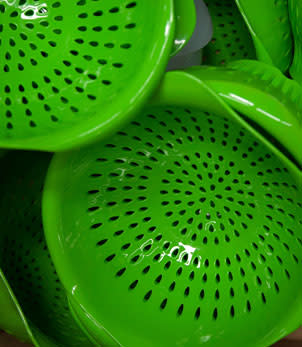Preserve: Proving Plastic Needn't Be Bad for the Environment

When Preserve founder Eric Hudson was meeting with plastics manufacturers back in the mid-'90s to make the first toothbrush for his new company, he would start by talking about how it would encourage better brushing.
Specifically, Hudson would walk would-be manufacturers through the unique forward-angle design, which he created with the help of his dad, a former car and boat designer.
It wasn't until the third or fourth meeting, when he thought he might have them sold on the idea, that Hudson would tell them what really made his brushes special.
Hudson didn't want to make the brushes out of new plastic, which is easy to work with. He wanted to use recycled plastics -- and not just any plastic, but No. 5 polypropylene, the stuff yogurt cups and bottle tops are made out of. At the time, most of it was ending up in landfills.
Out of that trash, Preserve would come to produce an entirely different creation.
Chapter 1: Redefining Sustainability
Hudson's reluctance to mention his vision upfront may seem strange now, but in the mid-1990s recycling was just gaining a foothold across America. While cities had begun collecting plastic, there were very few useful products being made from it, and none were being made from No. 5 polypropylene.
Hudson was neither a plastics expert nor an environmental crusader. But the Massachusetts native and former Fidelity securities trader was fresh out of Babson College, where he'd picked up an MBA and nurtured his entrepreneurial spirit. His grandparents were the founders of Brookstone, and his father was an industrial engineer. After years of trading stock, he longed to create something real. Now he just needed a product.

He'd always cared about the environment, and after reading a news story about the Fresh Kills Landfill on New York's Staten Island -- which was turning away trash barges because it was bursting at the seams with garbage -- an idea started taking shape.
"I remember reading about this and going, 'We're really running out of landfill space,' " Hudson says. "We really need to take on this recycling challenge and say, 'We've got to start converting this stuff into useful products made in the United States of America.' "
Speaking of useful products, Hudson had long been kicking around an idea for a backward-sloping toothbrush or idea for a reverse-angle toothbrush -- one that would allow him to brush as his dentist had always instructed. He worked with plastics and dental experts on the design, and a few months after submitting plans to the Food and Drug Administration, he was given the green light. Now he just needed a manufacturer.
Recycled plastics don't always melt and blend as neatly as virgin materials, so they can be hard to work with. Hudson eventually found a company in Tennessee willing to take up the challenge.
The next challenge would be find consumers to buy it and use it. Did the world need another toothbrush, especially one made out of garbage?
"Does it make sense to launch a product everybody uses, and that everybody uses in their mouth, made from recycled materials?" Hudson remembers asking himself. "Is this OK?"
Two decades later, the answer is yes.
Preserve is now a well-established company with 13 employees, a massive supply chain, and four manufacturing partners making not just toothbrushes, but also razors, reusable tableware -- including plates, cups, and cutlery -- and kitchenware items like colanders and food-storage containers.
Hudson no longer downplays the environmental angle. He puts it right on the company's packaging: "Made with love and recycled yogurt cups."

